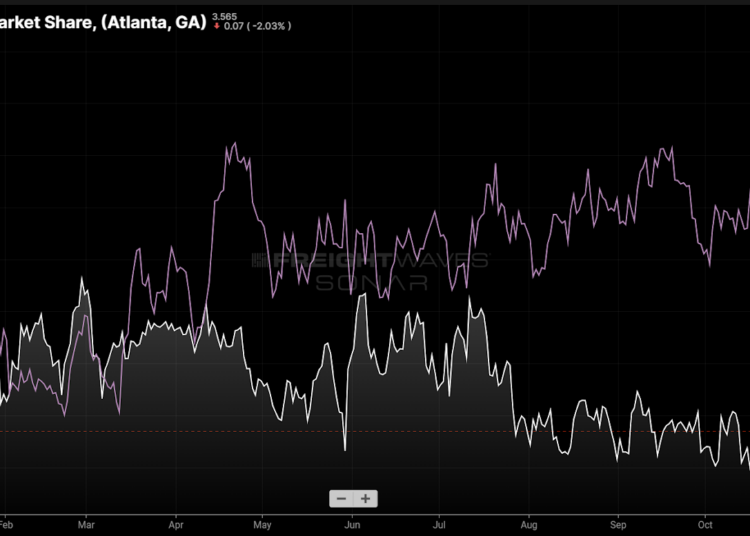Chart of the Week: Outbound Tender Market Share – Atlanta, Ontario SONAR: OTMS.ATL, OTMS.ONT
Atlanta’s percent of total U.S. freight market volume has fallen more than 11% over the past year, according to FreightWaves tender volume data. On the other side of the country, the Ontario, California, market has recovered over 14% of its share of the outbound trucking market. Supply chain shifts and a relatively inexpensive transportation market are driving forces.
Freight takes the path of least and generally cheapest resistance. During the pandemic years of 2020-21, the West Coast port and rail infrastructure was overwhelmed, causing prices to skyrocket and service to deteriorate around the nation’s largest port complexes of Los Angeles and Long Beach.
Imports from Asia represent a large percentage of freight volume in the U.S. and most of that entered through the Southern California ports as it is the fastest and cheapest route — until the pandemic.
Importers were forced to find alternative pathways to bring their freight into the U.S. and diverted shipments into Eastern ports with more frequency. Ports like Savannah, Georgia, a feeder for Atlanta market freight demand, exploded.
Many thought much of this volume would stick, but that has somewhat faded. Savannah currently represents approximately 7.44% of domestic maritime import shipments, down from its peak value of 7.9% in 2022 and up slightly from 2019’s 7.3%.
With drought impacting the Panama Canal’s larger Neopanamax locks this fall and the conflict in the Middle East creating problems for ships around the Suez Canal, importers are seeing more reason to resume shipping into the nation’s largest port complex in Los Angeles and Long Beach.
The Inbound Ocean TEUs Volume Index (IOTI), which measures bookings of twenty-foot equivalent units by departure date from the port of lading, for Savannah is down 20% annually this past week. The IOTI for the Port of Los Angeles is up 73%, a trend that has been relatively consistent since this past spring.
Other than geopolitical and environmental disruptions — both increasing themes over the past several years for supply chains — cost is an undeniable factor.
Maritime container rates spiked from China to the North American West and East coasts in 2021-22, but not proportionately at times. When the spread is smaller, it makes shipping into the Eastern ports more favorable. The cost of surface transportation is also a huge factor.
In December 2021, the average dry van truckload spot rate from Los Angeles to Philadelphia was $9,600. The cost of shipping from Savannah to Philadelphia was $2,650 — a difference of nearly $7,000.
At the same time, the cost of moving a forty-foot equivalent unit from China to Los Angeles was ~$14,600 versus ~$16,500 from China to Savannah — a difference of $2,100. If service is similar, and at this time it was more than likely better, shippers could save nearly $5,400 per shipment moving their goods into the East Coast.
The current spot rate from Los Angeles to Philadelphia is $5,300, and Savannah to Philadelphia is $1,450. The spot rate for containers from China to LA is around $1,600 and to Savannah is $2,300. This would make the savings around $3,150.
The savings is still there to an extent, but the service scenario has reversed. The total value proposition of shipping into the East has dramatically fallen and subsequently so has the surface freight volume originating in the Atlanta market.
Freight demand moving back to the West Coast could make it easier for the market to destabilize as carrier networks are typically more strained when they have to cover longer distances. This shift back to another pre-COVID shipping pattern may reemerge as another supply chain pain point when capacity finds more of an equilibrium with demand.
About the Chart of the Week
The FreightWaves Chart of the Week is a chart selection from SONAR that provides an interesting data point to describe the state of the freight markets. A chart is chosen from thousands of potential charts on SONAR to help participants visualize the freight market in real time. Each week a Market Expert will post a chart, along with commentary, live on the front page. After that, the Chart of the Week will be archived on FreightWaves.com for future reference.
SONAR aggregates data from hundreds of sources, presenting the data in charts and maps and providing commentary on what freight market experts want to know about the industry in real time.
The FreightWaves data science and product teams are releasing new datasets each week and enhancing the client experience.
To request a SONAR demo, click here.
The post Atlanta becomes casualty of imports returning to West Coast appeared first on FreightWaves.














